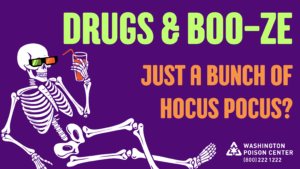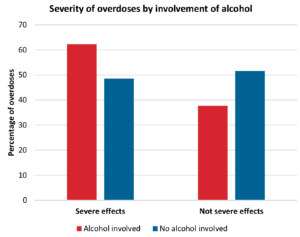
Hey boo, Washington Poison Center here. We’re sure you’ve heard health authorities talk about how dangerous it is to mix drugs and alcohol. Are those concerns real, or are they a bunch of hocus pocus? We’ll give you the low down so you can make safe, informed decisions this weekend.
It’s not hocus pocus… mixing drugs together can make you very sick. Why? The effects of different drugs can combine to overwhelm your body’s essential processes (like breathing), or they can mask each other so that you don’t know when you’ve had too much. The time it takes for drugs to work also varies a lot. So, you might drink to a comfortable buzz, then get pushed over the top by a drug that takes longer to set in.
Let’s look at some specifics:
- Alcohol and downers (like opioids and sedatives): Both slow your brain and body down, which can increase the risk of your breathing stopping.
- Alcohol and uppers (like cocaine, meth, and molly): Alcohol is a downer, so when you mix it with an upper, you might not feel the effects of either drug as much. This might encourage you to use more, which can overwhelm your body and cause you to overdose.
- Alcohol and psychedelics (like mushrooms and LSD): Alcohol can distort the effects of hallucinogenic drugs, making you extra confused and more likely to become overly anxious.
Why is the poison center talking about this? We’ve helped a lot of people over the last few years in Washington who got sick from mixing substances:
- We helped 35,750 people who overdosed on a combination of drugs and/or alcohol.
- Alcohol was involved in about 15% of these overdoses.
- Overdoses involving alcohol tended to be more severe than overdoses with other combinations of drugs (62% versus 48%).
- People with severe effects needed medical treatment in some form. More people who mixed alcohol with drugs were ultimately admitted to the hospital, instead of being discharged from the emergency room (30% of alcohol-involving overdoses versus 24% of no-alcohol combinations). A higher percentage also needed intubation, where a tube is inserted down your throat to help you breathe (8% of alcohol-involving overdoses versus 4% of no-alcohol combinations).

Severe effects include serious changes to heart rate or blood pressure, decreased organ function, confusion, decreased ability or inability to breathe, coma, seizures, abnormal heart rhythms, and organ failure. Not severe effects include nausea, vomiting, and drowsiness.
The safest choice is not to mix, but if you do, here are some ways to help reduce harm.
- Start slow and small: start with a small amount of each substance and wait a while to see how your body reacts. Even if you know how you react to a single substance, remember that you might react differently when two or more substances are combined. Start with a lower amount than you would normally use.
- Stay hydrated to reduce the strain on your heart and lower your risk of overheating.
- Have a sober buddy present who can call for help, recognize signs of overdose, and help you get safely home. They can also help keep an eye out for individuals who might take advantage of you. Learn more about sexual assault drugs in one of our previous posts.
- Always carry naloxone (NARCAN), which will help reverse an opioid overdose.
- An overdose or a bad reaction can happen fast. If someone is having trouble breathing, is passed out, or is having seizures, call 911 right away. Remember that you and the individual are protected by Washington’s Good Samaritan Law.
We are also here to help you, without judgement. Call us at 1-800-222-1222 to ask questions before you use, or if you have concerns during. We just want you and your friends to be ok, and we’ll be here to guide you as you need us. We’ll make sure you get the specific help and answers you need, when you need it.
